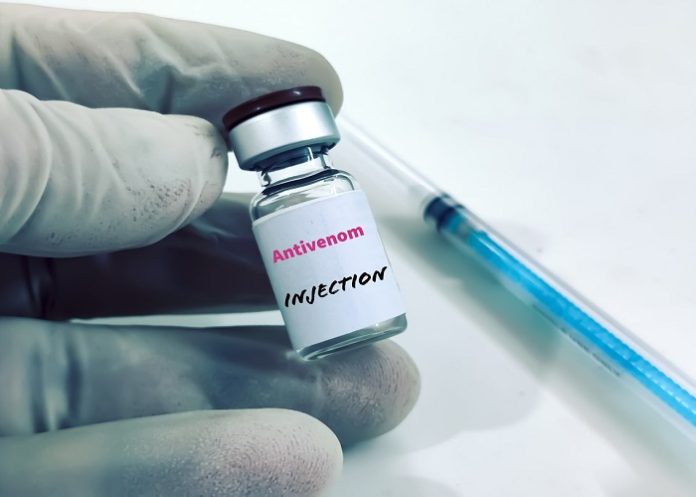Self-taught US venom expert Tim Friede has voluntarily injected himself with snake venom 856 times across 18 years. Now, his extremely dangerous hobby has led scientists to create the most widely effective snake anti-venom on record.
Collecting pet snakes since his youth, Friede first began to deliberately envenom himself by milking his pets, diluting their venom, and injecting it repeatedly. When he received two separate cobra bites in the space of an hour, the venom almost killed him.
“I basically flat-lined and died,” he said. “It wasn’t fun. I had enough immunity for one bite, but not for two. I completely screwed up.”
Friede was not put off. His self-envenomation regime, he realised, was probably the main reason he survived the incident. He doubled down.
In the following years, Friede’s immune system faced horrors unknown. Either by syringe or by fang, his B cells were introduced to the toxic bites of Egyptian cobras, water cobras, coastal taipans, Mojave rattlesnakes, even black mambas.
Luckily, his cells began to produce antibodies that protected him from the toxic regimen.
Friede is still alive, and his unique antibodies are actually being put to good use. His self-filmed YouTube videos attracted the attention of Jacob Glanville, immunologist and CEO of biotech company Centivax.
Using Friede’s hyperimmune antibodies, Glanville and a team of scientists have now created an anti-venom that, in lab experiments, protected mice from the venom of 19 different snake species, all listed by the World Health Organisation as category 1 and 2 of the world's deadliest snakes.
Usually, anti-venom is created by collecting the antibodies produced by sheep or horses that have been repeatedly exposed to venom from just one snake species each. That’s why anti-venoms tend to be specific to a species and region. And because the antibodies aren’t from humans, there’s always a risk of adverse reactions.
An anti-venom derived from Friede’s blood, on the other hand, could protect against a range of species with fewer complications.
The anti-venom tested by the team comprises two different antibodies isolated from Friede. The first, LNX-D09, was effective against six of the snake species tested on mice.
When paired with a drug called varespladib, the anti-venom barrier shielded mice from the venom of three more species of snake.
The second type of Friede’s antibodies, SNX-B03, extended at least partial protection to the entire panel of species’ venoms.
“By the time we reached three components, we had a dramatically unparalleled breadth of full protection for 13 of the 19 species and then partial protection for the remaining that we looked at,” said Glanville. “We were looking down at our list and thought, ‘what’s that fourth agent?’ And if we could neutralise that, do we get further protection?”
Glanville has universal anti-venom in mind: a single cocktail that could save anyone, anywhere, from any species of snake that might have bitten them. What his team has developed so far brings this closer to being realised.
This work focused on one major family of venomous snakes, known as the elapids, and it may work against other species in that family that weren’t directly tested. In time the team hopes to develop a similarly wide-acting anti-venom for the other main family, the viperids.
“We’re turning the crank now, setting up re-agents to go through this iterative process of saying what’s the minimum sufficient cocktail to provide broad protection against venom from the viperids,” said biologist Peter Kwong at Columbia University.
Rigorous clinical testing will be needed before the anti-venom could become available to humans. In the meantime, the researchers plan to conduct field trials of the anti-venom to treat snake-bitten dogs presented to veterinary clinics in Australia.
The research was published in Cell Press.
Study details
Snake venom protection by a cocktail of varespladib and broadly neutralising human antibodies
Jacob Glanville, Mark Bellin, Sergei Pletnev et al.
Published in Cell Press on 2 May 2025
Highlights
• We report a systematic method for the construction of a broad-spectrum snake antivenom
• Broadly neutralising antitoxin antibodies were identified from a venom-immune subject
• Broad toxin neutralisation involved recognition of conserved toxin-receptor interfaces
• A 3-agent cocktail blocked envenomation by 19 diverse WHO Category 1 and Category 2 snakes
Summary
Snake envenomation is a neglected tropical disease, with 600 species causing more than 100 000 deaths and 300 000 permanent disabilities in humans annually. Broadly neutralising antibodies and broad chemical inhibitors have been proposed as solutions, but how to develop a therapeutically effective cocktail and the number of required components have been unclear. To address this gap, we iteratively recovered two broadly neutralising anti-venom antibodies from the memory B cells of a hyperimmune human donor with extensive snake venom exposure. The antibodies recognized conserved neutralising epitopes on prevalent long and short snake neurotoxins, with crystal structures revealing antibody mimicry of the interfaces between these neurotoxins and their host target, the nicotinic acetylcholine receptor. We combined and tested these antibodies and the phospholipase inhibitor varespladib. A 3-component cocktail rescued animals from whole-venom challenge of all species in a 19-member WHO Category 1 and Category 2 elapid diversity set, with complete protection against most snakes observed.
See more from MedicalBrief archives:
Snakebite anti-venom crisis fuelled by ‘useless’ medicines
Anti-venom failure leads to novel toxin immunology discovery

